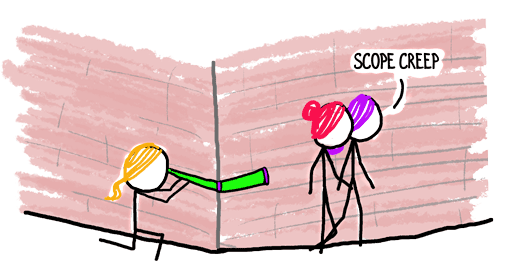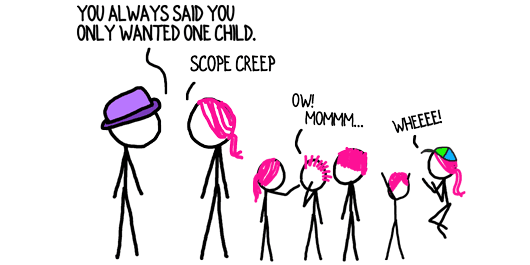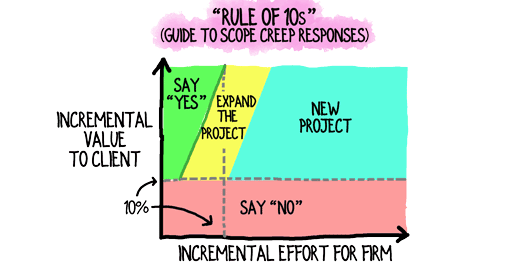Picture yourself presenting your final results from a project to your client. The meeting is swimming along smoothly and you’re basking in the warm glow of another happy client.
Then, your client asks, “Buddyboy, could you slice the data one more way so we can see impact by geographic area?” Setting aside your confusion over a client calling you Buddyboy, do you run the extra analysis or not?
Since the client loved your final presentation, he has another request: “Can you fly out again to present to the entire executive team?” Your team of three would lose a full day for the extra presentation. Do you fly or stay home?
Let’s say you choose to fly: the executive team loves your presentation too. “Buddyboy,” your client gushes, “the executive team wants you to come out one more time to present to the Board.” Is Buddyboy a term of endearment or has the client forgotten your name? Either way, do you fly or stay home?

Let’s look at a different scenario: you’re at a conference assessing four competitors for your client when your cellphone buzzes. It’s your client. “I see competitor #5 is at the conference too. Can you assess them also since you’re there already?” Do you or don’t you add the fifth competitive assessment?
How about this: you’ve launched the final design for your client on a project that already took far more time and effort than you expected. He calls and you immediately mention that you’re not Buddyboy. Puzzled, he continues, “Can you make one tweak to the design? It should take you guys less than five minutes.”
If he’s right that it would take very little time, do you tweak or not? What if it would take two hours? What if he calls again two weeks later with a similar request. Grant it or say no?
Last scenario: your client loves the materials you’ve provided for his senior leaders. He asks whether he can make copies for the next level down. Grant permission or not?

Scope creep is insidious and frustrating. Your consulting firm is paid for your skills, expertise, and the value you provide. Presumably you agreed with your client on a scope of work and a commensurate fee.
Now they want more work but aren’t offering more remuneration. Seems unfair. What do you do?
An Ounce of Prevention vs. a Ton of Grief
Your best defense against scope creep occurs before you submit your proposal.
- Discuss common and obvious scope creep possibilities in advance. If you know that other competitors may attend the conference or that design tweaks can go on forever, raise those scenarios with your prospect before you write the proposal.
- In your proposal, clearly articulate in each alternative what’s included and what’s not
- Make important boundaries explicit. For instance, dissemination of your IP, duration of access to you, the definition of the subject of your work, etc.
- Set high fees. High margins make it easy to say yes to most requests (as long as they’re not asking for work they declined during negotiations.)
The Rule of 10s
If project boundaries are fuzzy, consider contributing up to 10% more effort that produces 10x the value. Measuring effort and value can be subjective, but the Rule of 10s give you guidance.
Say “No” Gracefully
Even your “No” should sound like “Yes.” “Yes, we can absolutely do that for you. Of course, we’ll need to expand our relationship (or the engagement) a bit.”
Another graceful way to say no is shifting the conundrum to your client. “Since your request is outside the scope of the current engagement, how would you like to structure it so that you get this important, additional value, and we are compensated for generating that extra value?”
Accept Your Decision
If you say Yes, don’t begrudge the client. Do the work well, happily and without restraint. It was your decision to accede to the additional request, so don’t blame it on your client.
Where do you draw the line on scope creep, and how do you deal with your clients’ requests for more, more, more?
Text and images are © 2024 David A. Fields, all rights reserved.

 David A. Fields Consulting Group
David A. Fields Consulting Group 


As usual, excellent points. Unfortunately, too many consultants can’t conceive of, let alone provide for disruptive conditions when making their contract in the first place. One doesn’t have to perfectly anticipate all possible changes, just do better than the usual shortsightedness. That’s a key value of an effective RFP process, for instance. However, what I call “conventional we’s dumb” demeans RFPs and, especially in Agile, attention to contracts in general, mainly I believe because people aren’t familiar with them being done appropriately.
I find the biggest trap with the examples given is failing to recognize creep is occurring until it’s too late, which again happens more when there’s scant attention to scope in the contract. Such changes also are easy to accept because they indeed can be seen to produce a better project.
The examples cited are changes to the workplan or process; but I find frankly it’s more common for creep to involve changes to the product being delivered; and in my experience our industry woefully fails to understand why such changes occur and how better to avoid or at least reduce their impacts. Rather than the scope actually changing, much of creep actually is changing awareness of scope that could have and should have been identified but wasn’t’.
Substitute “Discovery process” or “Context Discussion” for “RFP process” and I’m right there with you, Robin. As you suggest, the best defense against scope creep is taking the time to think through possible challenges (or additions) to the project while you’re scoping it.
The situation you’ve brought up about the “product” changing is quite common in IT-related projects, less common in non-IT systems type projects and much less common in management consulting projects. What you’ve highlighted nicely is the types of scope creep and threats to the integrity of a project do vary depending on the type of consulting you’re doing. Thanks for raising that point.
Buddyboy? Never hear of him. Now Palomine – him I know.
Great reminder on the need to lay out the bright lines but to also know when they can be smudged.
Palomine… that was funny!
It’s knowing how to smudge, and how not to smudge forever that’s key. Thanks for the chuckle and for joining the conversation, Mike.
Great article. Sometimes scope creep can be an opportunity to ask for something in return. “Even though that item wasn’t included in our original engagement, I’d be happy to look at that additional data point for you. By the way, on that upcoming project your company is planning, can you help me with some insight on the structure of my proposal? I’d really appreciate your guidance.”
Although it’s usually best to outline the cost of add-ons early, sometimes the client doesn’t care. So the value of insight on a future contract today or a referral to another client may ultimately save you time & effort later which translates into $$.
Exactly right, Paul. In the 10 and 10 yellow zone of project expansion there’s room for all sorts of negotiation–all 14 of the Contract Tuning Keys are in play, including access to future projects.
I’m glad you highlighted that important aspect of the response to scope creep.
My question is how to get paid for scope creep.
In one instance, I made it clear up front that it was additional work beyond the proposal, and sent them an invoice (much less than the original project. They paid the project fee early, but not the incremental invoice. After a few attempts, I gave up. It seemed passive aggressive on their part.
Very recently, a client (at a very large company) had me ” burn the (after) midnight oil,” as his timelines were sped up. My fees were based on calendar time, with assumptions based on (generous) work hours. Now I’m left holding the bag, as we met the sped up timeline, and I put in the hours in fewer calendar days. As the client is part of a large company, the possibility of invoicing is gone once the client says the project is closed, and I could not bill more than the per diem along the way.
Suggestions?!
Very good questions and case studies. As you know, much of the problem is baked into your contract structure, and quite a bit of the rest of the challenge stems from accepting a new scope of work before receiving agreement from the client on the changes in fees.
As you’ve illustrated with your example, “informing” the client is not the same as gaining agreement from the client.
Unfortunately, the time to ensure you get paid for a change in scope is before you start the extra work. That said, in your situation, I would call your client and ask him for his help.
Thanks for being willing to share your situation, Winton. Feel free to reach out to me directly if you need more help.
Huh, you know our clients!? (Scope) Creepy. 🙂
This happens so often and it’s so easy to accept, only to realize what you thought would be a quick fix takes way more time than anticipated. At a time where resources are scarce everywhere, this is especially important to manage early on.
Both, the clarification in SOW and graceful “no”s are things we have done. What I hadn’t considered yet was addressing it up front verbally. Meaning previewing what might happen and what reaction it will trigger should it happen. At that point, you can treat it like a flashback, as in pointing out “remember when we chatted about how you might want extra reports… well, we can do that, but we’ll have to work on a change order or amendment to the SOW”. Really sets you up for a less awkward conversation down the road. Thanks for the tip!
As always, love the art work. So creative 🙂
Good for you for already being clear on your SOWs and forthright in your “No”s. As you said, previewing your response to scope creep request does make the later conversation less awkward. It also helps head off the request in the first place.
Interestingly, I was working with a team from Japan today and this same issue came up (same challenges everywhere, of course). There, however, cultural norms make it much, much, harder to combat scope creep. Your cultural permission to have a preview conversation is a significant advantage you have over that team from Japan–take advantage of it!
(Thanks for the thumbs up on my museum-quality drawings.)